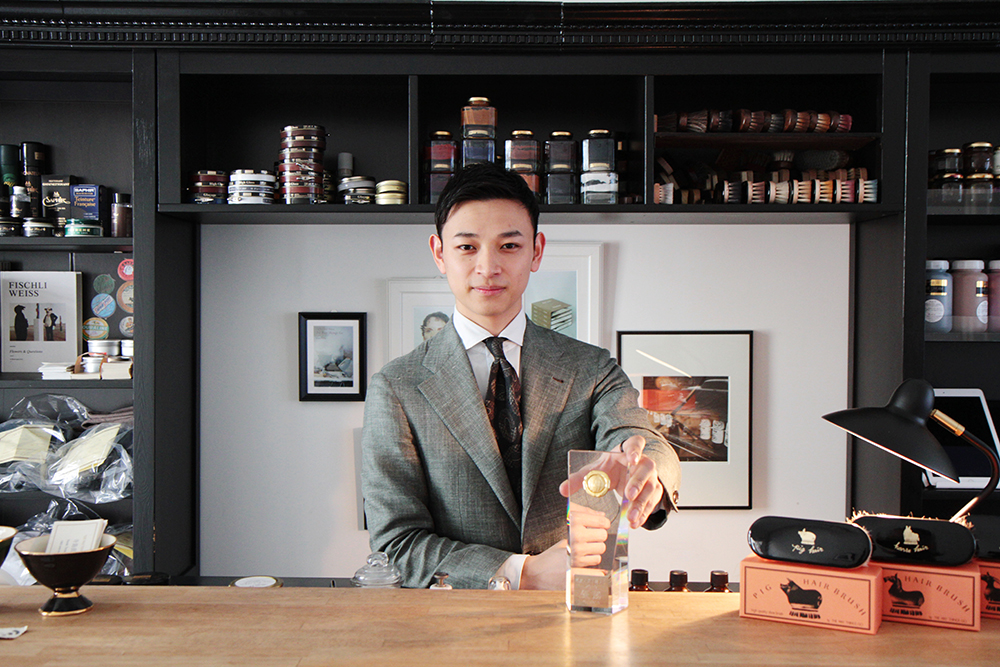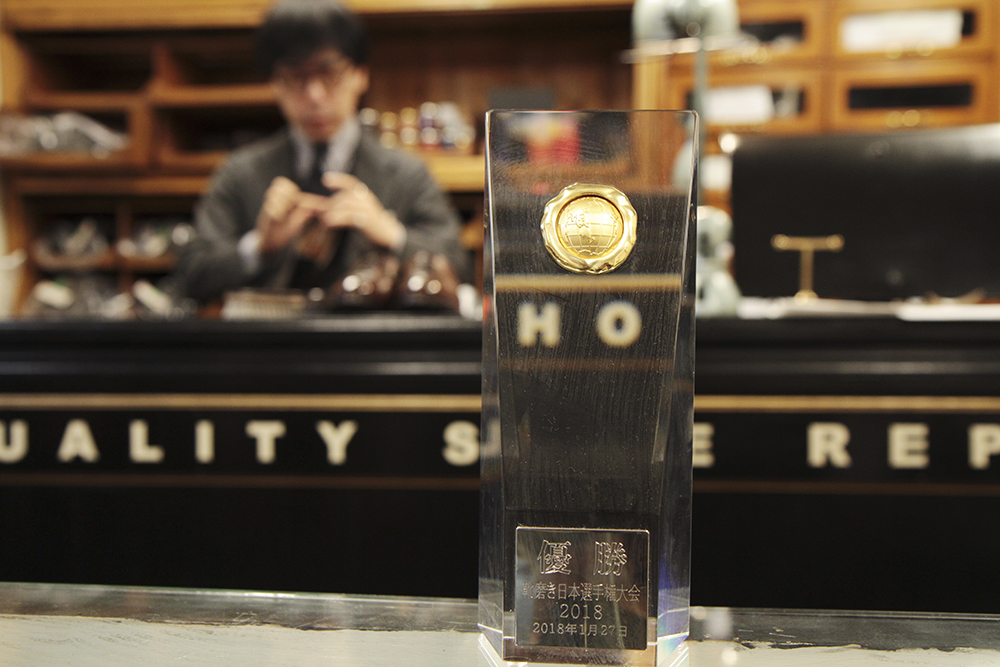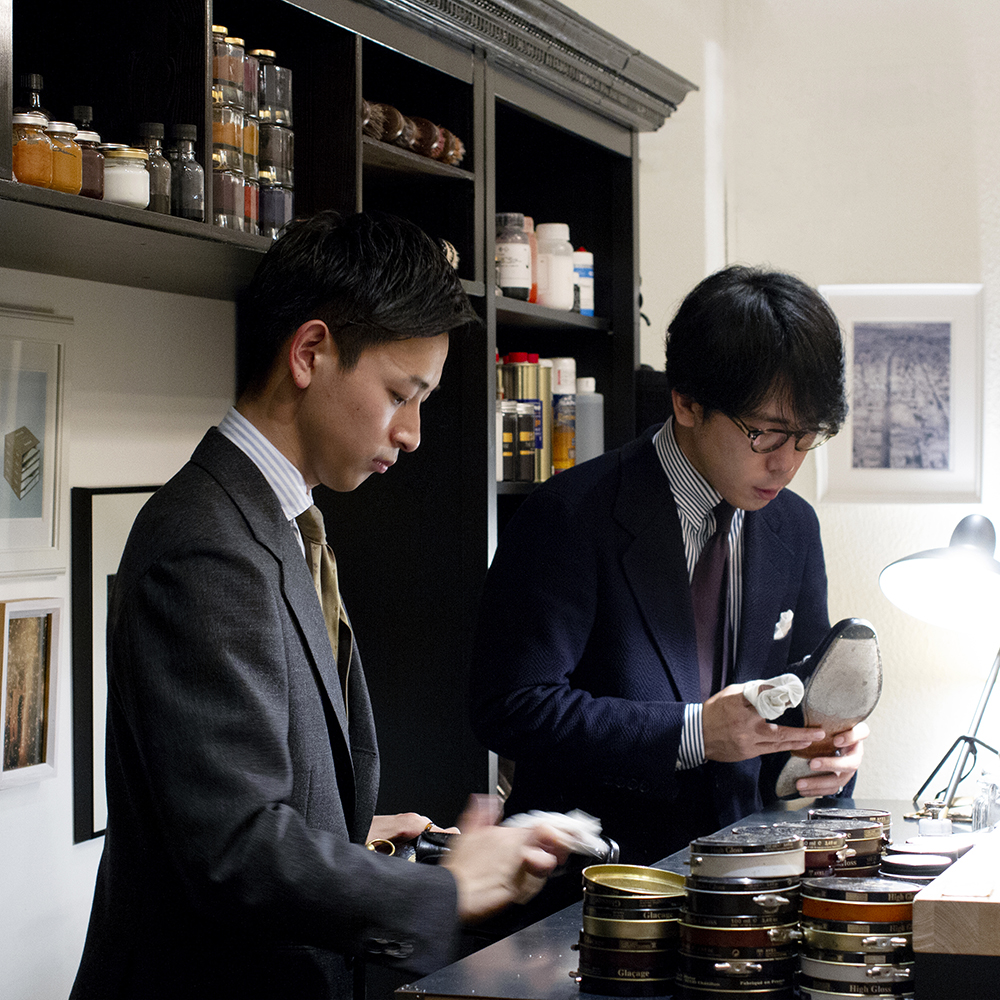
Last year, nearly fifty people, amateurs and professionals included, gathered into a room to compete for the title of being the best shoeshiner in Japan. The rules were simple. After the field was narrowed through a series of eliminations, the finalists were given twenty minutes to shine up identical pairs of shoes using the same leather cleaners, creams, and waxes (Saphir’s mirror gloss wax was banned because it makes producing a mirror shine too easy). Afterward, a panel of keen eye judges rated the shoes on dimensions such as the shine’s balance, refinement, and something called “movement.”
Competitions such as this one aren’t unique. In the last ten years, as interest in traditional men’s tailoring and footwear has grown, so has interest in adjacent fields, including bespoke craft and even the prosaic shoeshine. In Europe, there are multiple competitions, such as the one in Brussels and ShoeGazing’s contests around shoemaking, shoe shining, and shoe patinas. In East Asia, people upload videos onto platforms such as YouTube, where they present shoe care as high art. The Armoury has a shoeshine tutorial with former shoeshine champion Yuya Hasegawa. Another year’s winner, John Cheung, shows his technique for proper detailing. And these two videos are so downright soothing, they almost trigger the low-grade euphoria felt in ASMR.
Naoki Terashima won this year’s competition in Japan, scoring the second trophy in a row for the Osaka-based shoe care store The Way Things Go (the shop’s founder and owner, Gou Ishimi, won the 2018 title). Ishimi started the store in 2012 after having worked for ten years as a Prudential sales rep. Tired of his regular routine, he decided to take a chance on something he loved: shining shoes. His shop is named after a 1987 Swiss film, which was directed by the art duo Peter Fischli and David Weiss. “When I watched the film for the first time, I was so impressed by the backgrounds,” he said. “I imagined the hours of calculation, deliberation, and rehearsal necessary to make those backgrounds possible. It made me think that I could apply the same thought and consideration to what I do, so I named my store after the film.”
Since winning the competition two years in a row, The Way Things Go has garnered some attention from style enthusiasts. The Japanese YouTube channel Forza Style has a few videos featuring Ishimi and Terashima (possibly the result of a clumsy Google translation, this one is amusingly titled, “God’s hands of Japanese shoeshine king!”). Earlier this year, the company also opened a new store in Tokyo in collaboration with the shoe repair shop Union Works. We sat down with both men to talk about how readers can better take care of their leather footwear.
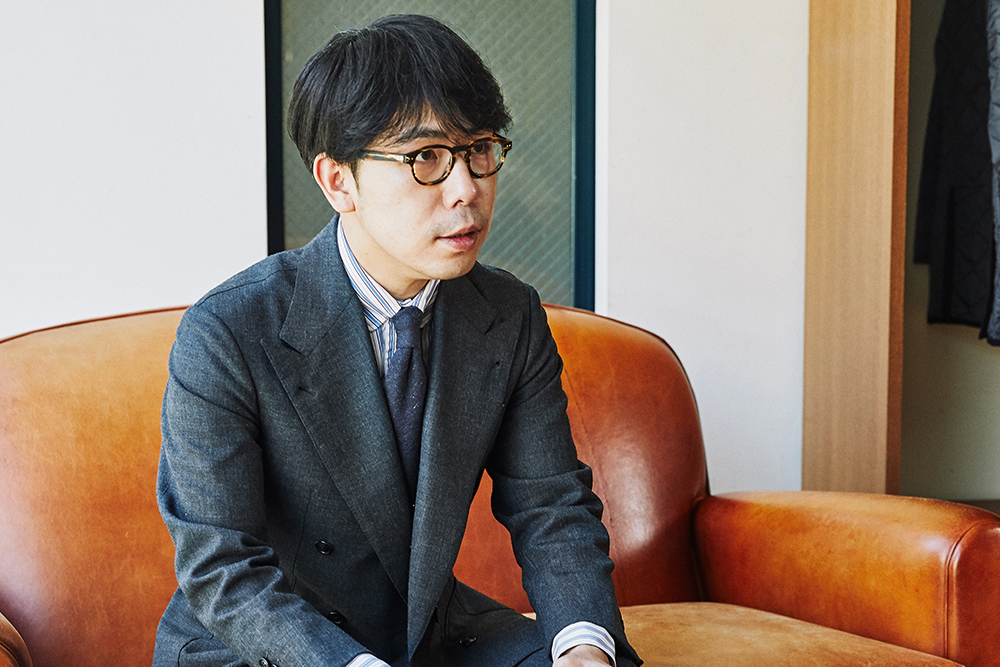
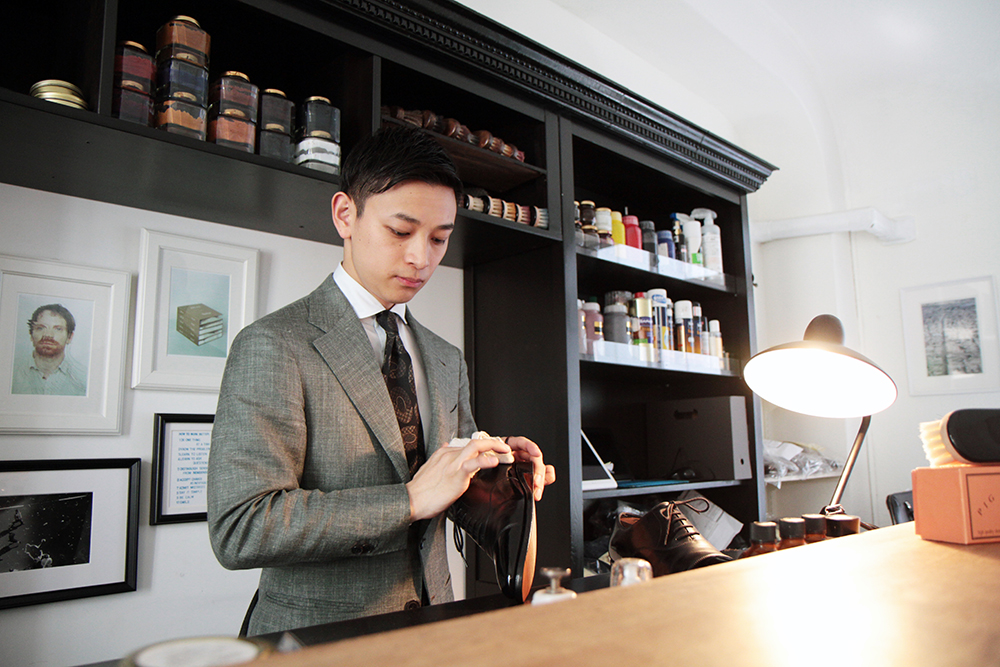
(pictured above: Gou Ishimi in a charcoal double-breasted suit, and Naoki Terashima in a lighter grey, single-breasted suit)
Most of our readers are familiar with proper shoe care — using cedar shoe trees, cream, and wax polish, and leather conditioner — but what do you think is often missed in a good routine?
Naoki: When brushing your shoes, pay attention to the gap between the sole and upper. Many people know that it’s essential to clean your shoes every once in a while with a horsehair brush, but they miss this area, which is where dirt and dust tend to accumulate. Also, when applying cream polish, take care to spread it around with a pig bristle brush, then wipe off excess cream with a soft cloth. This way, when you apply wax polish, the cream won’t get in the way of how the wax sits on the surface.
In some of your YouTube videos, you do a mirror shine. Typically, those take a very long time, sometimes up to an hour to complete. But you’re able to do it fairly quickly. What’s the secret to a better and faster mirror polish?
Gou: A mirror polish is about building up layers. You want to apply a bit of wax, then evenly flatten it out with a small bit of water. Repeat these steps for about an hour, so the layers build up to a smooth, glossy surface.
We do something similar, but we apply the wax with our fingers, which we find quickens the process so we can finish in about a tenth of the time. That means, we apply the wax, flatten it out with a bit of water for about five minutes, and then repeat. It takes about 20 minutes to complete a shoe at the heel and toe, but it’s all about feeling for the right combination. A lot depends on the hardness of the wax, the amount of water used, the type of cloth, and how you’re polishing. Since this is a very tactile thing, it’s hard to explain in words.
Who makes your favorite shoe brushes, leather conditioners, and polishes? And what makes those companies good?
Naoki: At TWTG, everyone uses the same products in the same ways. This allows us to control the quality of our services. Our shoe brushes are all original TWTG brushes. We have three types, each of which are designed for a specific purpose. We use Brift H’s cream polish because it penetrates the leather well and comes in a beautiful range of colors. For wax polish, we use Saphir’s. Their wax polishes have a lot of moisture, so you can add a sense of transparency to the finish.
Some readers like to burnish their shoes with a slightly darker polish for the toes and heel cup. Edward Green’s shoes, for example, come with this detailing. Do you have any tips on how to burnish shoes?
Naoki: Of course, you can use cream or wax polish to darken the tone of your shoes. But this comes with a bit of risk, as you can make the finish look uneven. I don’t really recommend using cream or wax polish in this way. When we do it, we dye the leather itself.
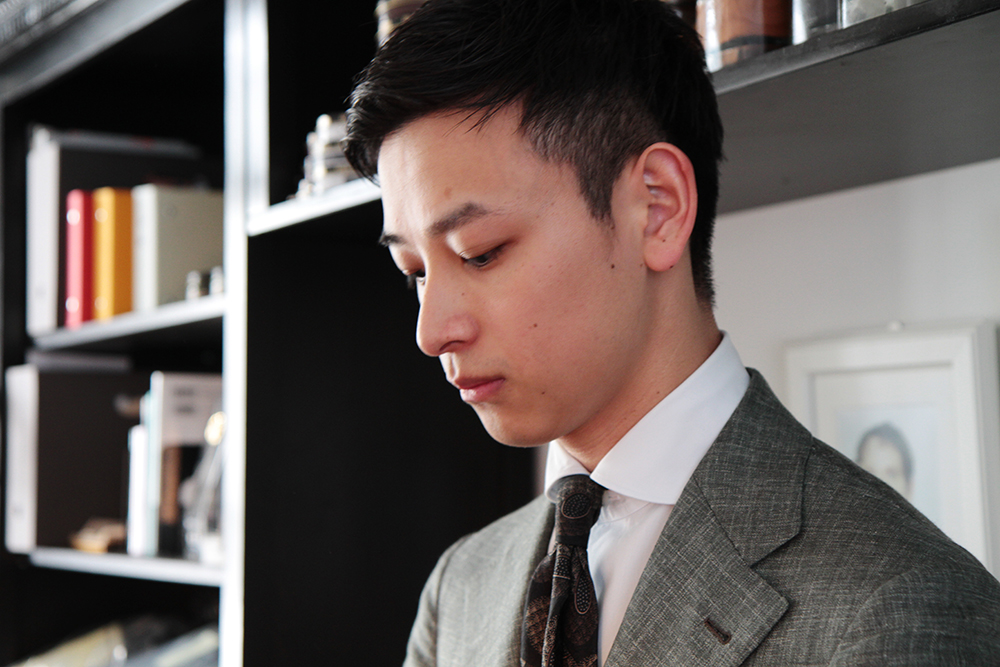
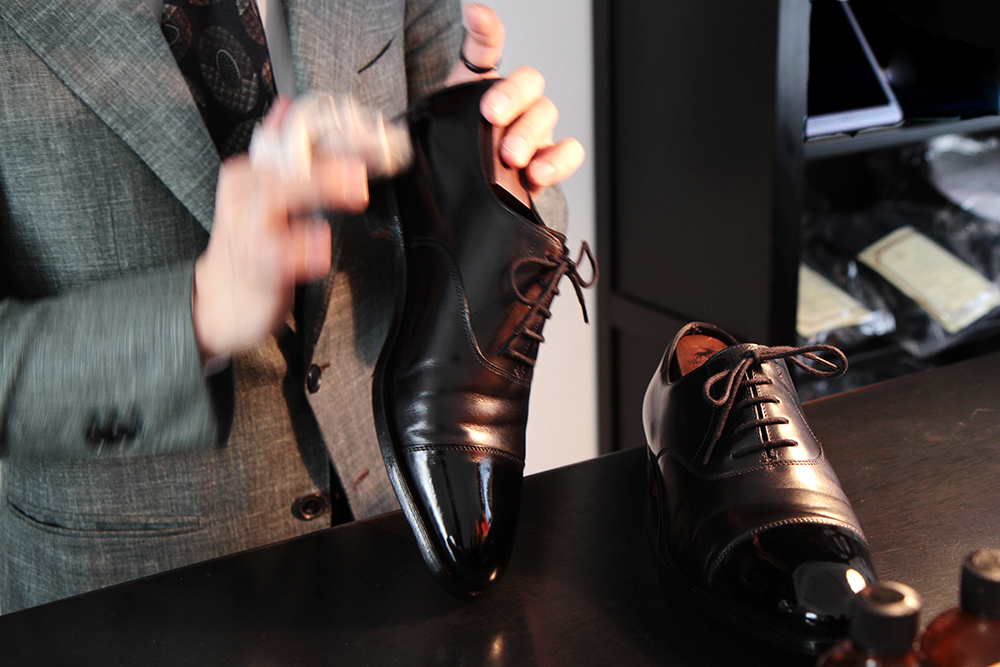
(pictured above: Naoki Terashima takes care of a pair of black, cap toe oxfords)
In the United States, some people use deer bones to bring up the shine on the shell cordovan shoes. One bespoke shoemaker in London, however, told me that deer bone is traditionally only used on waxed calf riding boots, not to shine shell cordovan. Do you have any views on whether people should be using deer bones on shell?
Naoki: In Japan, it’s not common to use deer bones for shell cordovan. We use the hard and rounded surface of water buffalo horns. When we use it, we rub it along the wrinkles.
I’ve seen a lot of different shoe shine brushes on the market. One company near you, Edoya, sells some made from goat hair, others in horsehair, and others still in pig bristle. Do you think these different types of brushes are necessary? Is it OK to just use a horsehair brush for everything and how should someone choose the right brush?
Naoki: We think it’s important to use the right brush. There are three main types, as you noted — horsehair, pig bristle, and goat hair. Horsehair has a medium hardness and is useful for removing dust. Pig bristle, on the other hand, is a little harder and is suitable for helping cream polish penetrate the leather, as well as making the leather a bit softer and more flexible. Since it comes in direct with cream polish, the bristles can get stained, so you need to own as many brushes as you use cream polishes. This way, you won’t spread black polish on a pair of tan colored shoes. Finally, goat hair is a bit softer and more delicate. It helps produce a more uniform look, so we like to use it for finishing. Goat hair brushes can also be used for daily care on shoes with a mirror finish. Otherwise, with a harder brush, you risk marring the glossy surface.
It seems shell cordovan often requires very different care from suede and calf. I’ve noticed that, when you put leather conditioner on it, the leather starts to look dull. And when it’s worn in the rain, the surface can develop bumps. Do you have any suggestions for how to properly take care of shell cordovan shoes?
Gou: Shell cordovan actually has a very fine, microscopic nap. To get a shine, you have to find a way to hold down the nap. Once you understand this, everything else becomes obvious. For example, when you apply leather conditioner, the leather can lose its radiance because the hairs raise up in response to the conditioner’s moisture. Similarly, when you wear shell cordovan out in the rain, water can penetrate the leather — not through it, but just under the surface. This, again, raises the hairs and makes the surface look bumpy.
To keep shell cordovan looking beautiful, avoid moisture. It’s also important to use something that can help hold the nap back for as long as possible, such as burnishing the surface with a smooth object. (Derek’s note: some people use deer bones for this purpose; Naoki above says they use water buffalo horn. I’ve gotten good results from using the back of a metal spoon. Obviously, if you use a spoon, you’ll want to use one that you can keep just for shoe polishing purposes).
Some other suggestions:
- If you use a leather conditioner on shell cordovan, use one with less moisture. And never wear them on rainy days.
- You can use soft, neutral wax on shell cordovan, but find something that’s harder and has less moisture. This way, the nap will be held down longer. Spread the wax across the surface of the shoes, but only use a small amount, as hard wax can break easily and dull the surface when it cracks.
- If you want to use a cream polish, apply it with a pig bristle brush instead of a horsehair brush. In Japan, many people believe they need to use a horsehair brush to spread the cream on shell cordovan, but a pig bristle brush will help spread the material more finely and evenly. After you’ve applied the cream, wipe the surface down with a soft cloth, and then hold the nap down using a deer bone or water buffalo horn.
If you keep to the rules above, you can maintain a shine on shell cordovan over the long run.
Sometimes readers email us to ask if they can change the color of their shoes. Meaning, if they purchase a pair of tan shoes, can then change the color to dark brown? If so, how should they go about it?
Noaki: You can change the color of your shoes, but it’s easier to make a pair of light colored shoes darker, rather than the other way around. We often get requests such as, “I stained my shoes and want to cover up the stain with a darker color.” Or “these shoes are too bright, and I’ve found they’re hard to match with other things in my wardrobe.” We recolor shoes using special dyes, which vary depending on the leather’s type and condition.
Lastly, what do you think are some things people often get wrong in shoe care? What should they pay more attention to?
Naoki: For daily care, it’s important not to be fussy. Some people like to do the full maintenance routine — using leather cleaner, cream, and wax — every time they wear their shoes. But they’re actually doing too much and may damage their shoes in the end. Buy shoes that can be easily resoled, such as those made with a Goodyear welt construction, and then take care of them when you need to.
(Many thanks to Mr. Gou Ishimi and Mr. Naoki Terashima for their time in answering these questions, and Ms. Maki Ishimi for serving as a translator. Readers interested in keeping up with The Way Things Go can follow them on Instagram, Facebook, YouTube.)
